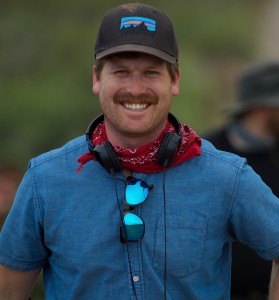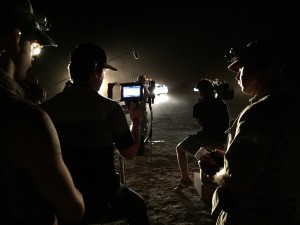Greg Kwedar’s debut feature, the SXSW Audience Award-winning film Transpecos, is being released in US theaters on 9/9 via Sam Goldwyn, a distributor responsible for early features from current directing luminaries like Morgan Spurlock & Noah Baumbach. A tense yet poetic thriller, the film follows 3 border patrol officers in the aftermath of a routine car stop gone wrong, and was the subject of glowing reviews out of the festival this year. By intensely focusing on, in Kwedar’s words, “what is behind the uniform, rather than on it” the film uniquely captures the the rhythms and challenges of the officers who work this largely overlooked beat.
Kwedar is now on the cusp of success, but took a roundabout route to this point—in college he dropped out of his accounting program, determined to focus on film, then rejected film school after being accepted. Worried he was making a big mistake, he was comforted when talking to the dean of the school who told him, “you could be pushing a hot dog cart in Santa Monica and get as close to the film industry as you can through these walls”. Rather than finding an LA hot dog cart, Kwedar traveled to Rwanda to produce a doc, and while there hatched the concept for Transpecos. After returning to the States he spent over 5 years researching and developing the film with no money and few connections, heading out to the Texas border to intimately learn the world he wanted to depict on screen.
Kwedar, along with his writing and producing partner, Clint Bentley, made incremental gains, but 5 years in, they seemed to be treading water when they decided to make a short film set in the world of Transpecos. That short, Dakota, which we’re premiering online today, debuted at Aspen ShortFest in April of 2015, and within 2 months production was underway on the feature. I talked to Greg this week via Skype to learn more about his story, how this surprising turn of events came to be, and what role Dakota had in his process of making the feature. The conversation is heavily edited for flow and clarity.
JS: Our readers won’t have seen it yet, but I have, and was really impressed—Transpecos has this great sense of place and character that you’re able to establish, how did you get started researching this world?
GK: The interesting thing about the Border Patrol is that it is one of our nation’s largest law enforcement agencies, but I’d say it’s the least understood, and I’d say that we don’t understand it because it is very secluded, and it is a very protective agency— it does not let outsiders in. But, with its massive growth since 9/11 undeniable, and without transparency, it allows for these very polarizing viewpoints to form, “hoo-rah America”, or “fuck these guys, they’re assholes”. The story of their humanity, the story in-between, was something I hadn’t thought we’d seen before.
We tried to get official access, but we hadn’t made a film before, and it all has to get cleared in D.C. even just for a local station. So what we decided to do was just drive out into the desert, find border patrol agents laying on their truck, bored out of their minds, and pretend we were lost Canadian tourists, with an upside down map. That started a conversation. Once we weren’t aggressive or nosy but just genuinely curious, it felt like pulling a bathtub plug, felt they had been closed off and hadn’t talked to anybody, and stories just poured forth. That led to deeper relationships, having beers with agents in these bars in one-stoplight towns, then the next layer of getting to know their families, and that’s when we started getting the stuff we were really interested in. It took a long time to get that trust.
JS: So that was still on a personal level, not on an official level?
GK: Yeah, even after we shot the film, to get the official permission we were going to have to give a lot more than we were willing to creatively. So what’s called a “Do Not Associate” was passed down on our film, which means they’re not allowed to interfere with our production, but they weren’t allowed to help us in any way.
But really we never made the film for the bureaucracy anyway, we were always interested in agents on the ground, and the agents on the ground always would go out of their way to find a way to our sets and the restaurants we were eating at and really supported us. And we had really solid technical advisors throughout.
JS: That’s a lot of preparation going into a spec script.
GK: It really leans into how I developed as a filmmaker: travel, experiential learning, documentary—landing in a world that fascinates me, finding characters that inhabit that place, what is their relationship to their setting, because I think characters are inherently in harmony or conflict with their setting, and then setting a story on top of it. To us the world of the border patrol was always there, and this West Texas setting, the characters were always there from the beginning too…but then the story changed multiple times. We did 5 or 6 1st page rewrites of the script.
JS: So you were on the border, you had done these years of research, at what point did you have a film, and what did you need to do next to get it made? Did you have a producer on board yet?
GK: We were actually at SXSW and were taking advantage of this section they have called Mentor Sessions—and it’s an incredible gift, where you get one on one time with these incredible artists and makers, just game changers, after you’ve been turned down maybe 40 times by these types before this. We had done several sessions and were leaving when I mention to Clint, “Oh look there is an opening, someone has just cancelled”, I saw the name, I hadn’t read the bio, but I said screw it, let’s sign up, it’s 10 minutes, and it was this woman, Nancy Schafer. (editor: Nancy was the first producer of the SXSW Film Festival, and more recently worked as the executive director of the Tribeca Film Festival)
We sat down and felt this immediate ease with her and a fast connection on a human, friend level. Afterwards she was like, “what are you guys doing next? I’m going to this place with free cocktails presented by X company”, and we ended up having drinks with her for the next 4 hours and her co-producer Molly Benson came and joined us. At the end they said, “well, we really like you guys, let’s see if your script is any good”. So we sent the script along, and they did, and joined on as producers.
At the same time I had been pursuing Josh Braun. I had met him at the Hamptons Film Festival Opening Night party when Rising From Ashes had premiered. I was at this party and had a few glasses of wine—drinking seems to a common thread in this interview–and I was like that’s Josh Braun! I had seen some panels he had been on, and I knew the work he represented, and I felt like I wanted to have a sales agent onboard the project at an early stage. It was a hunch I had, to legitimize the project and have someone weighing in on the choices we could be making to give it the best chances it has to carry on and give confidence to investors that the person who is going to sell your film is already part of it.
So I saw him across the room and walked up to him and said “HI I’M GREG KWEDAR” and shook his hand. He said “you have a really reassuring handshake”, and I thought, I’ll use it! So I sent him several emails over the next six months, saying “hey I’m the handshake guy”, and then that same SXSW he had an opening in his calendar, and I got to sit down with him with Clint. He had a personal connection to the story—he lost a friend, a border patrol agent who had died in the line of duty, and he also liked the script, so he got onboard at that time too as an executive producer and sales agent.
So those two things were in place, but we hadn’t raised a dollar. The script has started as this big unwieldily film, it had the characters and the world, but just lost itself…there are so many ways you can go in a world like border patrol, and it was a big film, a several million dollar type of film.
JS: Ok, so you’ve got some accomplished helpers onboard with Nancy and Josh, but are still struggling. What was their advice and when did Dakota enter your thinking? What were you hoping that it could accomplish?
GK: I was a little resistant to doing it actually, I was pretty hesitant to do a short. Deep down, the deep latent stuff going on, if I made it, and it sucked, then how the hell am I going to do a feature!? It had been years. I felt that I had matured as a human, that I matured as an artist, that I was the only one to tell this story about the border patrol, that it was in my marrow, it was in my blood, no one knew the story better than I did, no one knew this world better than I did as an artist. But, there was a fear of stepping out and shooting something. And I think my producers were a little nervous of me directing the feature, because there had been this long gap from my early shorts and there was not a strong case to qualify me as director for this feature.
JS: So was there talk about bringing in an outside director?
GK: Early on, Clint and I had a discussion of what if we could make this film for 30M or more with an amazing director, would you do it? And I’d always say, well, I’d be open to the conversation. But the confidence I held onto was that I was always a good team builder and good at recruiting great people around me, and that directing my first feature I would know the story better than anyone, and armed with those two things I could make a film.
Kwedar was hesitant to shoot a short, but a funny bit of serendipity fell their way. A Transpecos logo the team had commissioned from a graphic artist got licensed for use at an event for $7500 and suddenly there was budget for a short. Kwedar came around ultimately because he felt he had things to investigate in the short medium. He was immediately against the idea of a spec trailer, if they were going to do the effort to test out ideas for Transpecos why not tell a story that could stand alone? Also, Kwedar was deeply curious whether or not the things he found fascinating about border patrol would be interesting to others—the emphasis on the people behind the job, and not ripped from the headlines stories.
In the process he was able to test and refine what he wanted for the film. Stylistically he found out that he made Dakota much more formal than he wanted, with a locked-off camera style. This was counter to some of his main filmmaking inspirations like Alfonso Cuaron. He wanted to show a command and patience with the frame rather than give in to his handheld instincts, but in retrospect he was able to see that he put himself in a straight jacket. This formal approach taught him important lessons too however, like letting action happen in front of the frame. For Transpecos they would run complete scenes. A key sequence in Transpecos, a tense gun standoff, was a 10 page dialogue scene shot in an hour, and that scene ended up recruiting major collaborators in post-production like Aaron Dessner & Bryce Dessner of the band, The National, who came on as a composers.
Another key stumbling block that the short helped to unblock was theme. Dakota helped them home in on the “cycle of violence” that is a profound structuring element to the feature. The conflict of the short, bringing these two characters together and forcing them to confront their dehumanizing tendencies proved fruitful to the longer film.
Often you make a short for a prospective feature as a proof of concept. Kwedar demurs on whether this was beneficial, saying that the actors brought onto the film never saw the short, and whether the validation of the film’s Aspen debut helped with financing is unclear as well; he suggests it helped with some, but after 5 years of struggle, the process of shooting Dakota unlocked something in Transpecos that was undeniable. Kwedar relates:
GK: I’m just making this connection now, but after we did Dakota, we did another page one rewrite of the feature. And we wrote it in 3 weeks, and that became the shooting script. We premiered at Aspen Short Fest, we rewrote the script in 3 weeks, we raised the money in two weeks, and we were shooting in June. Aspen is in April, this all happened between April and June 8th. That was our first day of production. It went six years total, and until that point we had been lost at sea, and then this switch happened where we finally found — maybe that’s what the short did in a way, we really found what the feature should become, and once that happened, the doors opened for everything to come in: the financing, cast, timing, because the script was right.
The big revelation was the feature originally took place over a long period of time, several weeks, months. There was also a big reveal that was held to the end of the film. So what working on the short helped us discover was, could this whole story take place over the course of one day on the job, one shift? And could we reveal that twist in the first 10 minutes of the film? Then the story becomes a movie about consequences. Once those two things happened, once we had that path, we were able to take all this research, all these characters and it was insane how fast it came together.
The film had changed a lot by then, with a streamlined story it was no longer a multi-million dollar plus film and Kwedar ended up raising a budget in the high 6 figures from a mix of individuals in his friends and family network, and from professional film investors, who saw where the budget was now at and figured the team was a decent bet. Still, I was impressed with the way Kwedar had sold himself and his vision through the entire process he describes, bringing big-name collaborators and significant investors on-board to support the project when he nor Clint had much experience behind them. What was it about him and the work that convinced people to jump aboard with him, and what advice would he give to filmmakers in a similar spot to him?
GK: Hard question to answer, but I think it was that we were drawing from such a rich world, and that we had earned the right to that story, it was in our blood…
Here’s a thought, lately Clint and I have been dipping our toe into what does it look like to work in the industry, and so we’re pitching a lot, and you have to deeply understand two key questions surrounding your pitch— “Why Now” and “Why are you the one to do it?”. If you have something so compelling for those two, that’s what hooks people into wanting to be a part of it.
Who are the characters, what’s the story…that becomes secondary, it’s when you get people hooked, with a personal connection and there is urgency, and sense of inevitability that it will happen, that’s what leads to success.
JS: Sure, you weren’t just huddled off at a writing colony, you were putting in the work.
GK: We met a very celebrated TV guy at one of these meetings and he said this thing about us that maybe is what is connecting at these meetings — you’re sincere, imaginative and persistent, which to me, means you’re serious.
Thanks to Greg for the time and insight, Transpecos premieres in US theaters on 9/9, check it out if it comes to a town near you.
 Jason Sondhi
Jason Sondhi

